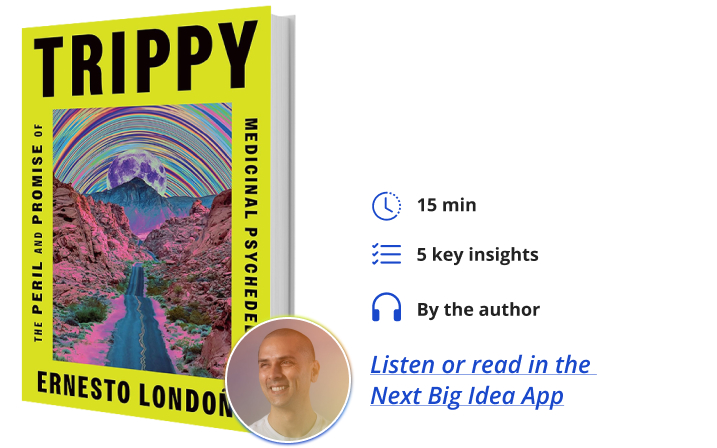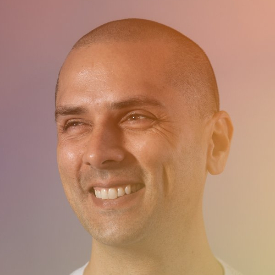Ernesto Londoño is a national correspondent at the New York Times, where he has worked since 2014. He was born and raised in Colombia and has spent two decades covering some of the most important stories of his generation. He covered the wars in Iraq and Afghanistan; the Arab Spring; served on the editorial board of the New York Times; and was the newspaper’s bureau chief in Brazil.
Below, Ernesto shares five key insights from his new book, Trippy: The Peril and Promise of Medicinal Psychedelics. Listen to the audio version—read by Ernesto himself—in the Next Big Idea App.

1. The hype is outpacing the science.
Over the past five years, there has been a surge of interest in the therapeutic potential of psychedelics. This was turbocharged by Michael Pollan’s 2018 book, How to Change Your Mind, which tells the fascinating history of a promising field of medicine that was hastily abandoned in the 1970s at the dawn of the War on Drugs.
Since Pollan’s book was published, the marketplace for medicinal psychedelics has exploded with a dizzying array of options. They include partaking in Indigenous rituals in the Amazon rainforest, Ketamine clinics in the United States, and celebrity-endorsed luxurious retreats in Costa Rica that promise a miraculous transformation—for a steep price.
There’s no question that psychedelics can be transformative for many people. Clinical trials have shown they induce significant and long-lasting changes in brain activity and mood. But our understanding of the ideal settings and safeguards for these experiences remains limited. It’s clear that for some people, these mind-bending experiences can be more destabilizing than healing.
There’s a lot we don’t yet know about how to screen patients for these interventions, like what kind of support is ideal before and after a session—and what kind of people should refrain from taking psychedelics. These are questions scientists have been investigating, though they are slow-going. Since many of these compounds are illegal, it is very difficult to study them.
2. Psychedelic churches have become the most accessible entry point for this kind of therapy.
Over the past few years, many underground psychedelic guides in the United States have stepped out of the shadows and begun operating openly after filing paperwork to operate as a church. Congress and the courts have set a very high bar for the government to interfere in the religious affairs of Americans. Starting in the 1980s, the government began granting some exceptions to drug laws to allow the sacramental use of psychoactive substances such as peyote—which has long been used by members of the Native American Church—and ayahuasca, a tea from the Amazon that is used by a couple of Christian denominations.
“How do you distinguish between a bona fide church and a retreat business masquerading as a church?”
The Supreme Court tackled this issue in 2005 with a unanimous ruling that validated the idea that these compounds can be sacraments. That ruling has emboldened dozens of people to start new churches, which has raised thorny questions. Are some practitioners electively practicing unlicensed medicine under the guise of spirituality? How do you distinguish between a bona fide church and a retreat business masquerading as a church? Should the Drug Enforcement Administration have the authority to decide which groups are genuine churches and which aren’t?
The courts are currently wrestling with some of these questions across the country. Some church leaders are the targets of law enforcement investigations. Others have decided to sue the government, seeking explicit permission to administer psychedelics. One of these new churches was founded by a woman in Austin who is a former crack addict and stripper. Her four-day retreats often include veterans struggling with severe trauma and depression.
3. Veterans are on the front lines of the psychedelic renaissance.
The cast of characters trying to broaden access to psychedelics as medicine is wildly diverse. They include respected clinicians, investors, liberal activists who oppose the war on drugs, and spiritual leaders. But a common thread is that nearly all of them have found ways to put veterans and their mental health challenges at the heart of their activism.
The growing number of veterans seeking these unconventional treatments has created strange bedfellows in politics. Some of the leading proponents for funding research into psychedelics and expanding these treatments happen to be very conservative lawmakers. They, of course, have allies who have long favored a more permissive approach to drug policy.
4. Something really special happens when people embark on a healing journey in small groups.
Having attended several psychedelic retreats, one thing that has struck me time and time again is how quickly people bond during these intense experiences. After each psychedelic session, participants generally do a communal debrief the morning after. These tend to be deeply moving and powerful moments. People share some of their deepest, darkest secrets with perfect strangers. There are so many tears. There are so many hugs. It is extraordinarily moving. There is something powerfully cathartic about hearing echoes of your own demons in other people’s stories.
“This approach could also make a dent in our epidemic of loneliness.”
As wonderful and helpful as a good therapist can be, there is value in creating more settings where people can process pain and trauma communally. Group therapy won’t be appealing to everyone, but it may be a way to make therapy more accessible, affordable, and effective for many. This approach could also make a dent in our epidemic of loneliness. So many of the people on psychedelic retreats become dear friends.
5. While writing about psychedelics and mental health care, I disclosed my experience with depression—and I worried.
Would people see me as damaged goods? Might it close some professional doors? Ultimately, I decided these were risks I was willing to take. Here’s why: When I’ve been in a dark place, I’ve drawn so much strength from the stories of people who have shared stories about depression, suicidal ideation, and trauma. They made me feel less alone. They gave me hope.
On some level, I wanted to pay it forward. As I had more candid conversations about mental health—with relatives, friends, and strangers—something unexpected happened. I felt increasingly unburdened. I encountered little judgment and a lot of compassion. It deepened many of my relationships. It made me feel less alone.
To listen to the audio version read by author Ernesto Londoño, download the Next Big Idea App today:































